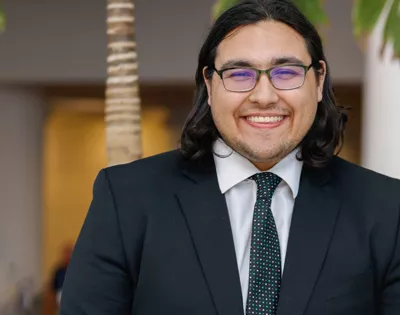Educators are well-versed in Maslow’s Hierarchy of Needs. If students’ basic needs aren’t met—food, shelter, safety, and security—then it’s difficult for them to achieve success in the classroom.
Yet many states blithely ignore this basic principle when it comes to the well-being of student teachers, who typically work without pay for year.
Fortunately, some lawmakers are starting to see the light. With teacher shortages at crisis levels, some states are passing laws that provide stipends for eligible student teachers. And the impassioned advocacy of many NEA Aspiring Educators (AE) has helped push these laws across the finish line.
A $5,000 win in Kentucky!
Matthew Callahan, who grew up in a small town in northern Kentucky, knew from an early age that he wanted to become an educator. This was due in large part to his own teachers: “I got into education because of the teachers that I had ... for the positive representation of adulthood that they showed me,” he says. “And I want to be able to model that same form of positive representation for my future students.”

A senior at Murray State University in Kentucky, Callahan became involved in his university’s AE chapter soon after he arrived on campus. He’s now president of the Kentucky Education Association’s (KEA) Aspiring Educators program.
In early 2024, Callahan led a group of AE members to meet with Kentucky legislators during KEA’s Public School Advocacy Day. At the top of their agenda? Advocating for a bill that included a salary of up to $5,000 for student teachers during their 70-day training period.
The prospective teachers shared their personal stories with lawmakers, explaining how much the stipend would help them. They reminded legislators of their responsibility to work for the betterment of society as a whole and, Callahan adds, “that we are the ones who elect them.”
Their advocacy paid off: The bill passed, and Kentucky Gov. Andy Beshear signed it into law in April. Eligible student teachers in Kentucky started receiving a stipend for the 2024-2025 school year. Currently, the stipend only goes to permanent Kentucky residents, but Callahan and his fellow AE members are fighting to expand the program’s eligibility to include out-of-state students.
The passage of the student stipend bill will have immediate practical effects for many student teachers.
“First and foremost, I will be able to afford rent,” Callahan says.
States that Pay Student Teachers
$9,600
$11,000 or $22,000
$20,000
Progress on Pay in New Jersey

In 2023, New Jersey Gov. Phil Murphy announced he was including a Student-Teacher Stipend Pilot Program in the state’s budget. Through this program, the state’s Higher Education Student Assistance Authority administers $3,000 to student teachers during their clinical practice semester.
Similar to Kentucky, the stipend is currently limited to permanent residents. But AE members are working to change that, says Matthew Yuro, a senior at The College of New Jersey and former president of the NJ Aspiring Educators Association. The $3,000, while helpful, Yuro says, “is just not enough money.” He and other AE members are fighting for a bill that would provide student teachers with $7,200 for both their Clinical I and Clinical II student teaching semesters. The larger stipend would be transformational for student teachers, Yuro says, and could help with mileage reimbursement, tuition costs, food and rent, among other expenses.
At the time of reporting, the bill was still in committee.
On the cusp of victory in Illinois?
Anabella Chlada, a junior at Illinois State University and the chairperson-elect of the Illinois Education Association Aspiring Educators, hopes that her state will soon join Kentucky and New Jersey in guaranteeing pay to student teachers.
Chlada is exactly the type of teacher Illinois schools should want to retain. A special education learning behavior specialist, she is passionate about improving education for marginalized communities and, she says, for "those who have disabilities ... and intersectional identities that may make it harder for them to participate in the school system as it stands.”
But like most education majors in Illinois, Chlada will have to make sacrifices. When she student teaches next year, she plans to save money by moving back in with her parents. “It’s not the most ideal situation,” Chlada says, but she knows she is lucky. Some of her peers don’t have that option.
Chlada has become a leader in efforts to pass a state law that would pay student teachers. In March, she gave testimony at the Statehouse in support of a bill that calls for a $10,000 stipend per semester for student teachers.
Quote byAnabella Chlada

“Student teaching ... is our first true attempt at paving the way for the next generation and ensuring we become excellent educators. ... However, the Aspiring Educators of Illinois State University are surrounded by anxiety when we think about spending up to two semesters without having a paid position. How are we going to afford housing? Tuition? Meals? Gas?”
Lawmakers listened and voted yes in May. However, the bill still needs to make it through the Illinois legislature in the fall, Chlada says. She plans to continue her advocacy for paid student teaching until the bill becomes law.
“Especially with the educator shortage right now, it's essential that we get quality educators, and a lot of them are being turned away due to financial barriers,” Chlada explains. An incentive like paid student teaching, she says, would show “that society values our educators and values what they're doing for our students.”
Get Involved
Want paid student teaching in your state? Aspiring Educator chapters can organize meetings with lawmakers, Callahan says. “Help [lawmakers] understand how this issue affects you directly,” Callahan advises. “Unless they’re aware that Aspiring Educators are going to get out and get involved and get voting, then they’re not going to take this issue seriously.”
To support more paid student teaching efforts, contact NEA Senior Policy Analyst Blake West, [email protected].

